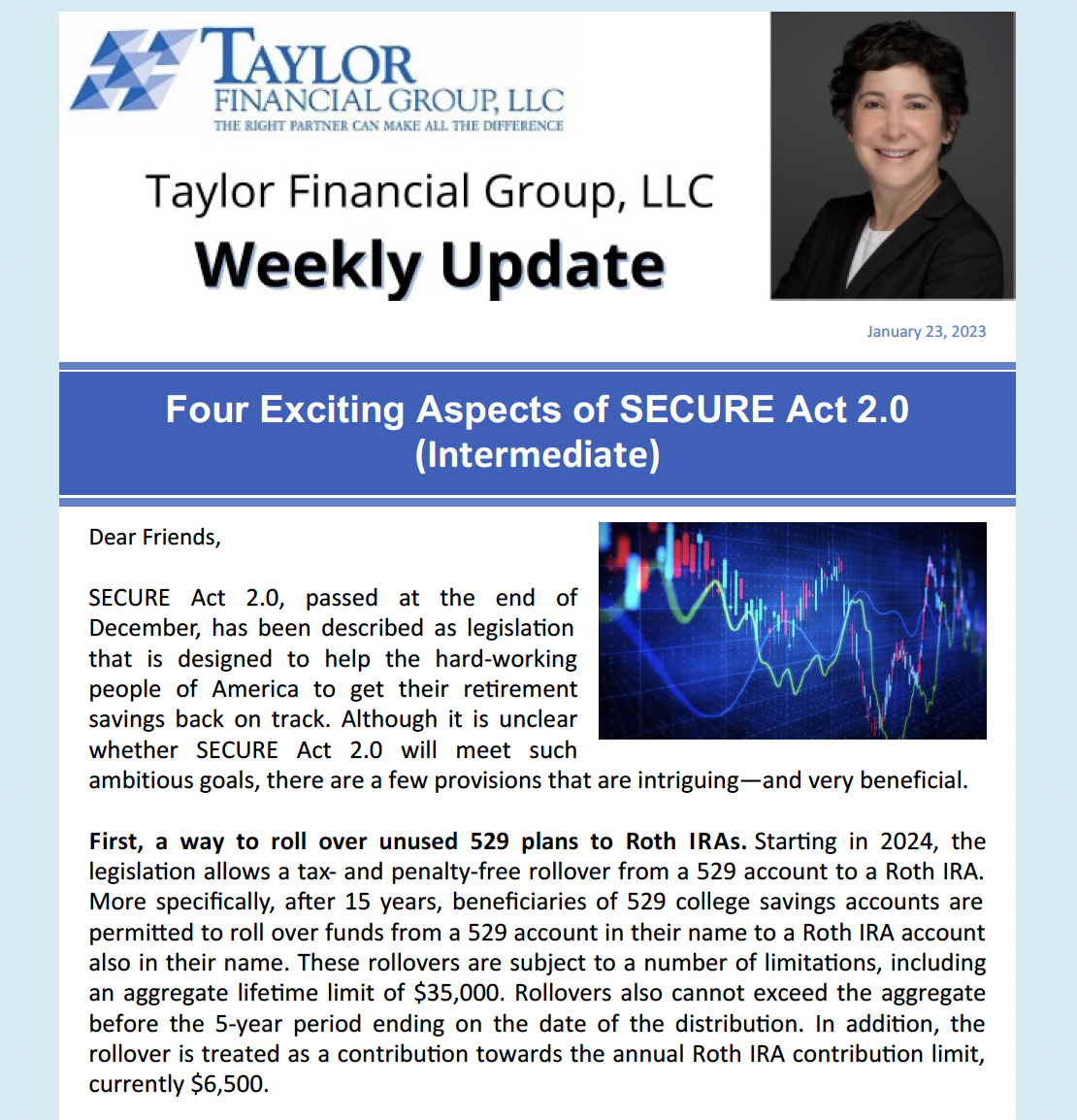By Debra Taylor, CPA/PFS, JD, CDFA™
Dear Friends, SECURE Act 2.0, passed at the end of December, has been described as legislation that is designed to help the hard-working people of America to get their retirement savings back on track. Although it is unclear whether SECURE Act 2.0 will meet such ambitious goals, there are a few provisions that are intriguing—and very beneficial.
First, a way to roll over unused 529 plans to Roth IRAs. Starng in 2024, the legislation allows a tax- and penalty-free rollover from a 529 account to a Roth IRA. More specifically, aer 15 years, beneficiaries of 529 college savings accounts are Permitted to roll over funds from a 529 account in their name to a Roth IRA account also in their name. These rollovers are subject to a number of limitations including an aggregate lifeme limit of $35,000. Rollovers also cannot exceed the aggregate before the 5-year period ending on the date of the distribution. In addition, the rollover is treated as a contribution towards the annual Roth IRA contribution limit, currently $6,500.
Second, matching contributions to a Roth account for high earners. In an apparent attempt to raise tax revenue to offset the costs of other provisions, SECURE Act 2.0provides for certain matching contributions to be made on a Roth basis. Effective for tax years beginning aer 2023, catch-up contributions to 401(k), 403(b), and governmental 457(b) plans by employees whose wages exceed $145,000 (as indexed) must be made on a Roth basis. This Roth treatment of catch-up contributions is mandatory for any plan that makes catch-up contributions available.
Third, the expansion of QCDs and charitable contributions. At present, QCDs are capped at $100,000 per year, and that amount doesn’t go up each year. The SECURE2.0 Act allows the $100,000 limit to be adjusted annually for inflation (rounded to the nearest $1,000). The adjustments will begin in 2024. Note, for gifts to count, they must come directly from an IRA by the end of the calendar year. QCDs cannot be made to all charities. In addition, starng in 2023, a one-me QCD of up to$50,000 to charities is allowed through certain charitable remainder annuity trusts (CRATs), charitable remainder unitrusts (CRUTs) or charitable gift annuities (CGAs). The Act expands the ways in which people who are age 70½ and older can use trusts in tandem with charitable giving to potentially lower their federal tax bills. Starting in 2023, such people can make a one-time gift up to $50,000, adjusted annually for inflation, to a CRAT, CRUT or CGA. Essentially, the new rule on so-called qualified charitable distributions expands the types of “charities” that can receive the gift.
Fourth, the RMD options for surviving spouses grow. Special rules currently exist for determining when a surviving spouse must start taking RMDs from an inherited retirement account. One of those rules states that, if an account holder dies before RMDs are required and his or her surviving spouse is the beneficiary (and doesn’t change that status), RMDs from the inherited account aren’t required unl the year in which the deceased account holder would have reached age 72. The SECURE Act2.0 tweaks this rule by also allowing the surviving spouse to be treated as the deceased account owner for RMD purposes starng in 2024. In some cases, this will allow the surviving spouse to delay taking RMDs from the inherited account—e.g., if the surviving spouse is younger than the deceased spouse. Although I believe that much of the SECURE Act 2.0 is hyped, these four provisions are legitimately exciting.
As always, please reach out with any questions.
Debbie


